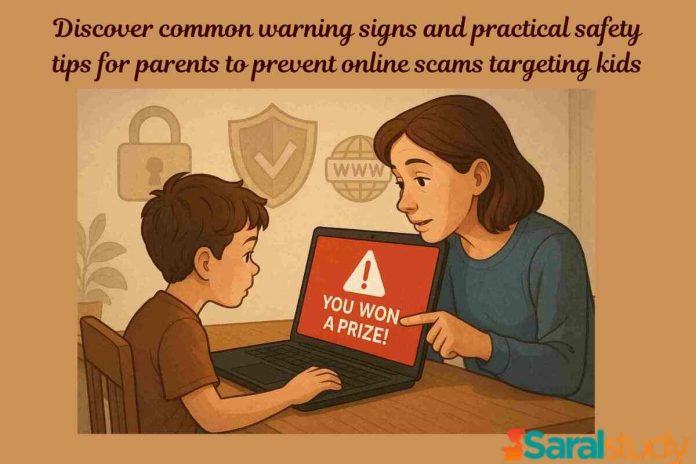The internet is full of entertaining apps, games and movies for kids of all ages. However not everything online is safe. Hidden among these entertaining platforms are internet frauds that target children with phony gifts, free game currencies or friendly looking people.
As a parent, you may believe that scammers only target adults; yet children are typically easier targets for online scams targeting kids since they are interested, trusting and less aware of danger.
In this article, we’ll teach you how to recognize typical internet Online Scams Targeting Kids, how they work, and how to keep your children from falling for them without instilling fear or cutting them off from the digital world.
Why are children often targets for online scams?
- Natural Curiosity: Children are curious explorers. When Children see a message like “Click here to win free robux or diamonds!” Their excitement can cause them to behave impulsively.
- Limited Online Awareness: Kids frequently believe what they see online, especially if it appears professional or features cartoon characters they recognize.
- Desire to belong: Scammers frequently masquerade as friendly gamers or influencers to earn children’s trust and make them feel welcome in online communities.
Common Online Scams Targeting Kids
Children can be scammed easily, here are given few methods by which they can be targeted easily:
Fake Game Rewards or Freebies
Scammers know kids love virtual rewards—like game coins, skins, or power-ups. They create fake websites or pop-up ads offering “free” rewards in exchange for login details.
Example: A child sees a YouTube ad that says, “Get free Minecraft coins—just enter your username!” Once entered, scammers steal the account or personal data.
Phishing Messages
Phishing is when scammers send fake emails or messages pretending to be from a trusted source.
Example:
An email might say: “Your Roblox account will be deleted unless you confirm your password.” Kids who panic and reply end up giving away access to their accounts.
Online Friend Requests from Strangers
Many scammers create fake profiles of other “kids” or gamers to start friendly chats. Over time, they may ask for personal details, pictures or even money through gift cards.
Scholarship or Contest Scams
Older kids or teens might see posts about scholarships, art contests, or giveaways that require a small “entry fee” or personal details. These are often traps to collect sensitive data or money.
Fake Apps and Downloads
Scammers create copycat versions of popular games or learning apps. Once downloaded, they may contain malware that steals information or infects the device.
Warning Signs That Something’s a Scam
It Sounds Too Good to Be True
- If a website promises huge rewards for free, it’s almost always a scam.
Asking for Personal Information
- Any site or person asking for your child’s full name, phone number, school name, or photo should be treated with caution.
Urgent or Scary Messages
- Messages like “Your account will be deleted!” are designed to create fear and rush decisions.
Poor Grammar or Spelling
- Scam messages often have spelling errors or strange sentence structures that reveal they’re fake.
Unknown Links or Pop-ups
- Links that redirect to strange pages or pop-ups that appear repeatedly are red flags.
How to Teach Kids About Online Scams
Use Real-Life Examples
- Explain scams in simple, relatable terms.
For example:
“Just like a stranger offering candy on the street, some people online try to trick you with gifts.”
Kids understand better when you connect online dangers with offline experiences.
Encourage Open Communication
- Let kids know they can always tell you if something feels strange online.
Avoid scolding them for mistakes – fear can stop them from asking for help next time.
Create a Family Rule for Sharing Info
- Make a simple rule like: “Never share personal information or click on links without telling an adult.” You can even print this rule and keep it near their computer or tablet.
Use Teachable Moments
- When a scam ad or message appears, use it as a learning moment.
Say: “See this message? It’s fake because it’s asking for your password.”
This helps to spot online scams targeting kids naturally.
Practice “Stop, Think, Ask”
Teach your child a simple 3-step safety habit:
- Stop before clicking anything.
- Think if it seems real or too good to be true.
- Ask a parent or teacher for help.
This rule helps them slow down and make safer choices online.
Tools Parents Can Use to Prevent Online Scams Targeting Kids
Enable Parental Controls
- Use parental controls on browsers, devices and gaming platforms to block unsafe sites and filter scam content.
Set Strong Passwords
- Help your kids create strong, unique passwords and teach them not to share them – even with friends.
Use Two-Factor Authentication
- Adding a second layer of protection prevents hackers from logging in, even if they know the password.
Update Apps Regularly
- Old versions of games or apps may have security loopholes. Keep everything updated.
Teach About Reporting Features
- Show kids how to report fake profiles, scams, or cyberbullying on the platforms they use.
What to Do If Your Child Falls for a Scam
Stay Calm and Supportive
- If your child admits they clicked a bad link or shared info, stay calm. Scolding may make them hide future incidents.
Change Passwords Immediately
- Secure all affected accounts and create stronger passwords.
Contact the Platform
- Report fake users or scams to the app or website. Many platforms can help recover lost accounts.
Teach the Lesson, Not the Fear
- Turn the experience into a learning opportunity. Explain how scams work and how to avoid them next time.
Building Awareness Without Fear
Keep Conversations Ongoing
- Don’t make online safety a one-time talk. Keep discussing new apps, games and websites your child explores.
Balance Trust and Supervision
- Let your child know you trust them—but still keep gentle supervision, especially with younger ones.
Focus on Empowerment
- Teach them that being smart online is about confidence, not fear.
Say: “You’re smart enough to check before clicking.”
Conclusion
Online scams are evolving every day and kids are not immune. But with open conversations, the right tools and a few smart rules, parents can protect children from online scams targeting kids without taking away their online freedom.
By teaching them to recognize red flags, pause before clicking and come to you when unsure, you help them build lifelong digital awareness from online scams targeting kids.
Remember, the goal isn’t to block every danger – it’s to raise kids who are confident, informed and safe digital citizens.
FAQs on Online Scams Targeting Kids
Q1. What are online scams for kids?
Online scams targeting kids are fake offers, messages or websites that try to steal personal information, money or online account access.
Q2. How do scammers reach children online?
They use gaming apps, social media, chat rooms, or even fake learning websites to send offers and phishing links.
Q3. What should parents do if a child clicks a scam link?
Immediately change all passwords, clear browsing data and run a security scan. Inform your bank if payment info was entered.
Q4. How can schools help prevent online scams targeting kids?
Schools can include digital safety lessons, teach kids to spot fake messages and organize awareness workshops with parents.
Q5. What’s the simplest rule kids should remember?
If something online seems too exciting, secret or urgent – don’t click it, don’t share it and tell an adult right away.
Also Read: How to Talk to Kids About Screen Time rules Without Conflict





